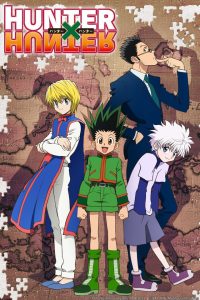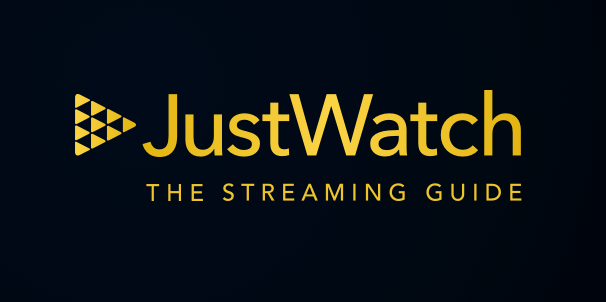International stream: Crunchyroll (US, Canada, UK, Ireland, South Africa, Australia, New Zealand; subtitles in English or French; and for those who may be wondering by now, yes, there are other streaming services, but Crunchyroll is picking up most of the simulcast licenses these days.)
Hunter x Hunter‘s closest Western approximation is probably Ripping Yarns, Michael Palin and Terry Jones’s satire of “boys’ own” adventure stories, but that comparison hardly begins to do it justice.
For a start, Hunter x Hunter has survived a lot longer, at 68 episodes and counting, and with less than half the extant manga it’s based on adapted so far. Rather than direct parody, its approach is a gleeful over-the-top-ness combined with an expert knowledge of the tropes of its genres. The typical Hunter x Hunter endorsement starts with, “I don’t normally like shōnen (boys’) series, but…”
“Genres”, plural? Yes, like Ripping Yarns, it switches from subgenre to subgenre as it feels like. It starts as a straight adventure, as 12-year-old Gon Freecss sets out in search of his father Ging, who is one of an elite organization of adventurers and fighters, the Hunters. Naturally this requires him to pass the Hunter Exam and become one himself, and just as naturally, the exam requires ridiculous feats of physical endurance.
Then the first genre switch: Gon and his new best friend, former child assassin Killua Zoldyck, go to Heavens Arena to engage in martial arts (of the kind of Flying Tiger, Hidden Dragon level of implausibility) and learn the mysteries of Nen, this world’s all purpose superpower/magic system. Then it’s off to a fantastical version of New York City (Hunter x Hunter‘s world has a very different geography from ours, but some places in it are meant to be recognized) for a dark, violent crime-story arc. And then, it engages full-on geek mode as Gon and Killua’s continuing search for Ging leads them into a video game. Up ahead, according to those who’ve read the manga, is a story arc building on more traditional sfnal/horror elements, and then something about the Hunter Association trying to elect a new chairman. Through it all, it’s intelligent, endlessly creative, and just a huge heap of all-out fun.
If you want to get into this one, it’s best to go back to the start of the current story arc, at episode 59, or wait for the next one. Although a thread of geekiness has been floating through the story ever since one of the Hunter Exam challenges turned into basically a violent lecture on Game Theory 101, here the author, who clearly has enjoyed many a tabletop RPG session, has allowed this tendency to come to the fore in this section. Between the game system and the new varieties of Nen abilities our heroes are stacking up, there’s a lot of explanation to absorb. But if you’re really, really determined to jump into the middle of it, I’ll give you a quick orientation. Let’s throw in another promo picture for some spoiler space…
So: Greed Island is the name of the game Gon (the black-haired kid) and Killua (the white-haired one) have entered to try to find Ging (top center), who is one of the people who created it. Actually, as some characters have figured out by now, Greed Island is a place in the real world that the “game cartridge” teleports people to– less Tron, more The Most Dangerous LARP. (Yes, someone has tried the obvious munchkin move, and yes, the gamemasters had prepared for this possibility.)
The game was intended as a fun and relatively harmless way for Nen users to train up their powers, but some players have more deadly intentions (griefers, they’re everywhere), and so it’s become a trap from which most people there just want to escape. Gon, however, has determined that he wants to complete the game. This means collecting 100 specific numbered cards plus a pile more of unspecified ones in his Pokédex magic binder, which means winning contests, completing quests, etc. in the typical RPG manner. Cards can also be used up to create items or cast spells, and a great deal of effort goes into collecting defensive spells. Also the number of some cards in the game is capped, allowing players to block each other from winning by monopolizing a card type.
As Gon and Killua go around collecting cards, they’ve joined up with Biscuit Kreuger (the girl– actually 57, but she chooses to take that form to catch people off guard), a Nen master who is helping them train up their abilities and develop signature moves.
Chief among the current villains is Genthru (mid right, with the evil hipster glasses), leader of the Bombers, who, as their name suggests, like to blow people up. Also wandering around are several surviving members of the Phantom Troupe, the badguys from the previous story arc (upper left), whose leader (top, far right) is currently under a curse preventing the use of his powers or any communication with his henchmen. That curse can, however be removed by a Nen exorcist– and there happens to be one playing the game. That’s Abengane (bottom row, second from left), who is also the only person to survive an attack by the Bombers, and has managed to warn Gon and Killua about them.
Since he’s unable to communicate with the others, the leader of the Phantom Troupe has instead hired Hisoka (near upper right), creep extraordinaire, to locate an exorcist. Hisoka has been around since the Hunter Exam, encouraging Gon to fully develop his powers. See, Hisoka’s great joy in life is to defeat strong opponents, but first they have to be strong enough to be worth fighting…
Hisoka has just entered into an uneasy alliance with our heroes, because they need the strongest players available to get past a particularly difficult challenge which involves various one-on-one contests between a group of players and one of the gamemasters (mid left) accompanied by 14 of his friends. And there, after a brief but very funny side trip to Aiai, the City of Love (where players cannot go more than ten steps in before being swarmed by NPCs trying to pull them into romantic cliche plots), is where things stand.
Right, got that? Onward!












